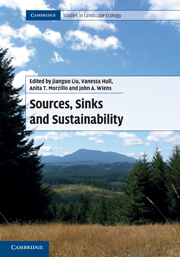23 - Sources and sinks: what is the reality?
Published online by Cambridge University Press: 05 July 2011
Summary
We consider four “realities” that may affect the usefulness of source–sink theory and thinking as applied to conservation and resource management. First, documenting source–sink systems requires detailed information on demography, dispersal, and habitat selection – information that is hard to come by. Second, source and sink patches are embedded in heterogeneous landscape mosaics, in which the details of spatial relationships are important. Third, source–sink systems are dynamic: what is a source or a sink can change with variations in regional population abundance or environmental conditions. And fourth, considering source–sink systems at too fine a spatial or temporal scale may artificially truncate their dynamics, while viewing them at too broad a scale may obscure or average away the critical interactions between sources and sinks; source–sink dynamics are scale-dependent. The upshot of these realities is that populations in different parts of a landscape may have quite different dynamics, which may change with time or changes in scale. Conserving or managing such populations requires direct or indirect information about landscape-specific demography and dispersal. It also means that protected areas should be established and managed with regard to current and future source–sink dynamics, including adequate landscape heterogeneity at a sufficient scale to allow source–sink dynamics to play out.
- Type
- Chapter
- Information
- Sources, Sinks and Sustainability , pp. 507 - 519Publisher: Cambridge University PressPrint publication year: 2011
References
- 5
- Cited by

